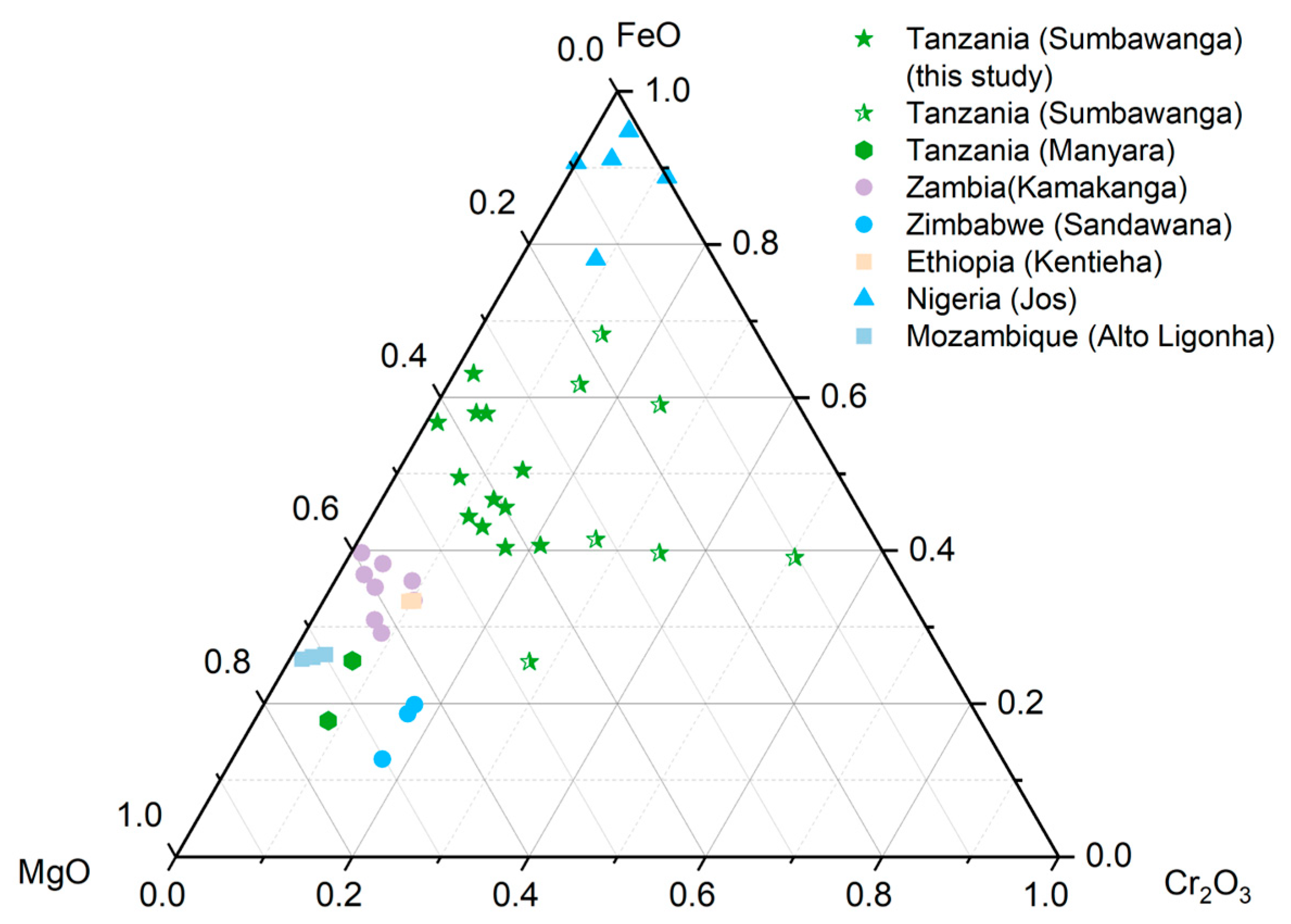Investigation of the Gemological Characteristics and Types of Inclusions of Emeralds from Sumbawanga, Tanzania
Abstract
1. Introduction
2. History and Geological Setting of the Sumbawanga Deposit
3. Materials and Methods
3.1. Sample Description
3.2. Gemological Analysis
4. Results
4.1. Gemological Properties
4.2. Microscopic Characteristics
4.2.1. Associate Minerals
4.2.2. Fluid Inclusions
4.2.3. Mineral Inclusions
4.3. Spectral Characteristics
UV-Vis-NIR Spectroscopy
4.4. Chemical Composition Characteristics
5. Discussion
5.1. The Unique Inclusion Assemblage in Sumbawanga Emeralds
5.2. Updated Features of Sumbawanga Emeralds
5.3. Identification of the Geograohic Originof Sumbawanga Emeralds
6. Conclusions
Author Contributions
Funding
Data Availability Statement
Acknowledgments
Conflicts of Interest
Abbreviations
| UV-Vis-NIR | Ultraviolet–Visible–Near-Infrared |
| EPMA | Electron Probe Microanalysis |
| Cr | Chromium |
| V | Vanadium |
| NW-SE | Northwest–Southeast |
References
- Saeseaw, S.; Pardieu, V.; Sangsawong, S. Three-Phase Inclusions in Emerald and Their Impact on Origin Determination. Gems Gemol. 2014, 50, 114–132. [Google Scholar] [CrossRef]
- Guo, H.; Yu, X.; Zheng, Y.; Sun, Z.; Ng, M.F.-Y. Inclusion and Trace Element Characteristics of Emeralds from Swat Valley, Pakistan. Gems Gemol. 2020, 56, 336–355. [Google Scholar] [CrossRef]
- Groat, L.A.; Giuliani, G.; Stone-Sundberg, J.; Sun, Z.; Renfro, N.D.; Palke, A.C. A Review of Analytical Met-Hods Used in Geographic Origin Determination of Gemstones. Gems Gemol. 2019, 55, 512–535. [Google Scholar] [CrossRef]
- Zheng, Y.-Y.; Yu, X.-Y.; Xu, B.; Gao, Y.-J. Characterizing Malysheva Emeralds (Urals, Russia) by Microscopy, Spectroscopy, Trace Element Chemistry, and Machine Learning. Crystals 2024, 14, 683. [Google Scholar] [CrossRef]
- Zhang, Y.; Yu, X.Y. Inclusions and Gemological Characteristics of Emeralds from Kamakanga, Zambia. Minerals 2023, 13, 341. [Google Scholar] [CrossRef]
- Zhang, Y.; Yu, X.Y. Spectroscopy and Trace-Element Characteristics of Emeralds from Kamakanga, Zambia. Crystals 2023, 13, 1605. [Google Scholar] [CrossRef]
- Moroz, I.; Eliezri, I. Mineral inclusions in emeralds from different sources. J. Gemmol. 1999, 26, 357–363. [Google Scholar] [CrossRef]
- Moroz, I.; Vapnik, Y.; Eliezri, I.; Roth, M. Mineral and fluid inclusion study of emeralds from the Lake Manyara and Sumbawanga deposits, Tanzania. J. Afr. Earth Sci. 2001, 33, 377–390. [Google Scholar] [CrossRef]
- Zwaan, J.C. Gemmology, geology and origin of the Sandawana emerald deposits, Zimbabwe. Scr. Geol. 2006, 131, 1–212. [Google Scholar]
- Huang, Z.X.; Li, G.; Weng, L.Q.; Zhang, M.L. Gemological and Mineralogical Characteristics of Emerald from Ethiopia. Crystals 2023, 13, 233. [Google Scholar] [CrossRef]
- Pardieu, V.; Sangsawong, S.; Cornuz, L.; Raynaud, V.; Luetrakulprawat, S. Update on Emeralds from the Mananjary-Irondro Area, Madagascar. J. Gemmol. 2020, 37, 416–425. [Google Scholar] [CrossRef]
- Saeseaw, S.; Renfro, N.D.; Palke, A.C.; Sun, Z.Y.; McClure, S.F. Geographic Origin Determination of Emerald. Gems Gemol. 2019, 55, 614–646. [Google Scholar] [CrossRef]
- Dirlam, D.M.; Misiorowski, E.B.; Tozer, R.; Stark, K.B.; Bassett, A.M. Gem Wealth of Tanzania. Gems Gemol. 1992, 28, 80–102. [Google Scholar] [CrossRef]
- Gavrilenko, E.V.; Pérez, B.C.; Bolibar, R.C.; del Amo, D.G. Emeralds from the Delbegetey deposit (Kazakhstan): Mineralogical characteristics and fluid-inclusion study. Miner. Mag. 2006, 70, 159–173. [Google Scholar] [CrossRef]
- Groat, L.A.; Giuliani, G.; Marshall, D.D.; Turner, D. Emerald deposits and occurrences: A review. Ore Geol. Rev. 2008, 34, 87–112. [Google Scholar] [CrossRef]
- Aurisicchio, C.; Conte, A.M.; Medeghini, L.; Ottolini, L.; De Vito, C. Major and trace element geochemistry of emer-ald from several deposits: Implications for genetic models and classification schemes. Ore Geol. Rev. 2018, 94, 351–366. [Google Scholar] [CrossRef]
- Cevallos, P.; Simmons, W.B.; Falster, A.U. Emerald from Sumbawanga, Tanzania. Gems Gemol. 2012, 48, 220–221. [Google Scholar]
- Dunn, S.C.; von der Heyden, B.P.; Steele-MacInnis, M.; Kramers, J.D.; St Pierre, B.; Erasmus, R.; Harris, C. Neoproterozoic copper-gold mineralization in the Amani area, southwestern Tanzania. Ore Geol. Rev. 2021, 132, 104070. [Google Scholar] [CrossRef]
- Sun, Z.Y.; Palke, A.C.; Renfro, N. Vanadium- and Chromium-Bearing Pink Pyrope Garnet: Characterization and Quantitative Colorimetric Analysis. Gems Gemol. 2015, 51, 348–369. [Google Scholar] [CrossRef]
- Shao, H.J.; Qi, L.J.; Zhong, Q.; Zhou, Y. Study on Characteristics of Iron-rich Hydrothermal Synthetic Emerald from Russia. J. Gems Gemmol. 2014, 16, 26–34. [Google Scholar] [CrossRef]
- Wood, D.; Nassau, K. The characterization of beryl and emerald by visible and infrared absorption spectroscopy. Am. Min. 1968, 53, 777–800. [Google Scholar]
- de Araujo Neto, J.F.; Barreto, S.d.B.; Carrino, T.A.; Muller, A.; Montefalco de Lira Santos, L.C. Mineralogical and gemological characterization of emerald crystals from Parana deposit, NE Brazil: A study of mineral chemistry, absorption and reflectance spectroscopy and thermal analysis. Braz. J. Geol. 2019, 49, e20190014. [Google Scholar] [CrossRef]
- Yang, Y.L.; Shen, X.T.; Fan, Y.R.; Huang, W.Z.; Pei, J.C. UV-Vis-NIR Spectroscopic Characteristics of Vanadium-Rich Hydrothermal Synthetic Emeralds from Russia. Spectrosc. Spectr. Anal. 2022, 42, 1199–1203. [Google Scholar]
- Liu, X.W.; Hu, Y.H.; Xu, Z.H. Effect of chemical composition on electrokinetics of diaspore. J. Colloid. Interf. Sci. 2003, 267, 211–216. [Google Scholar] [CrossRef]
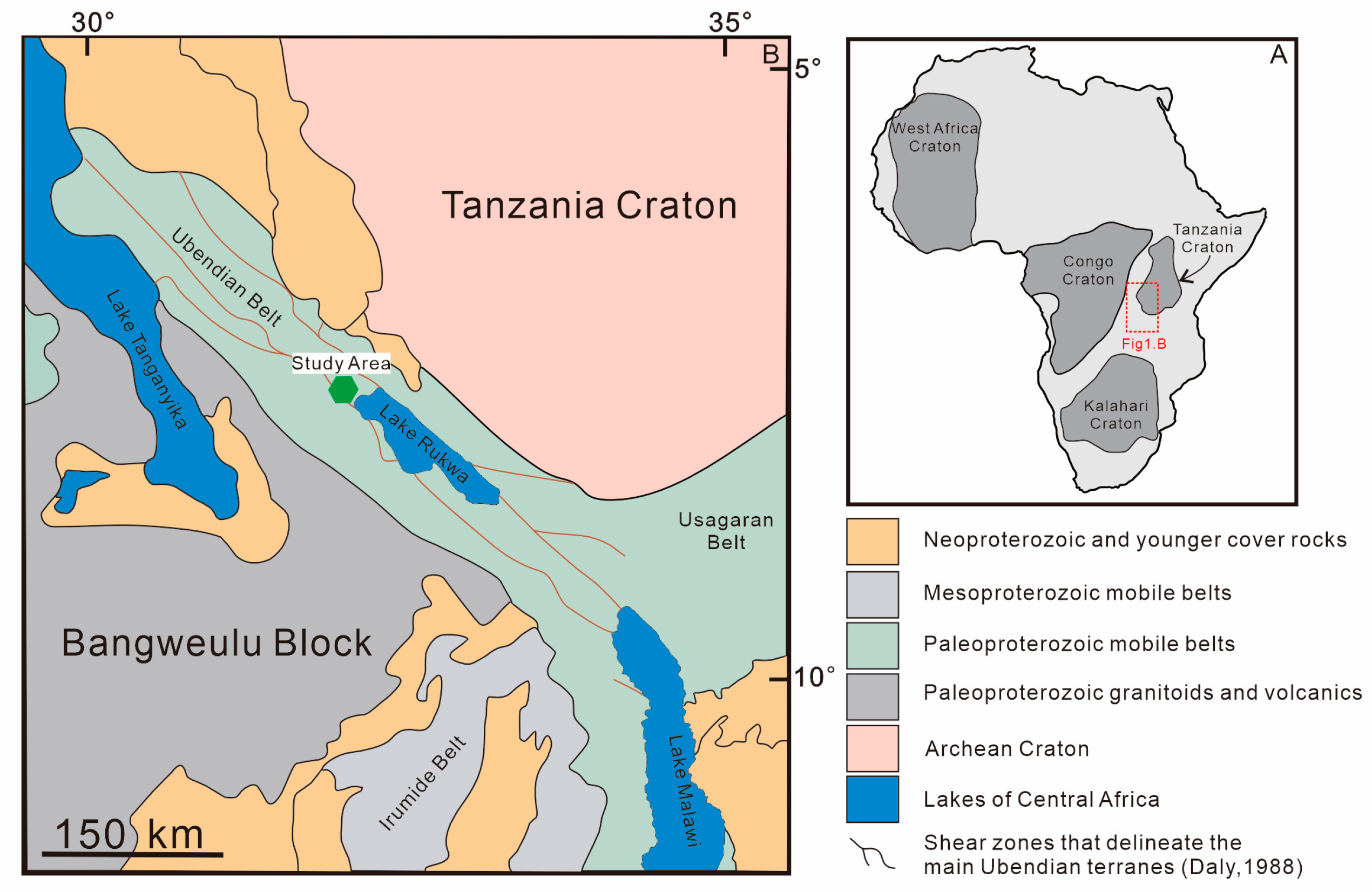
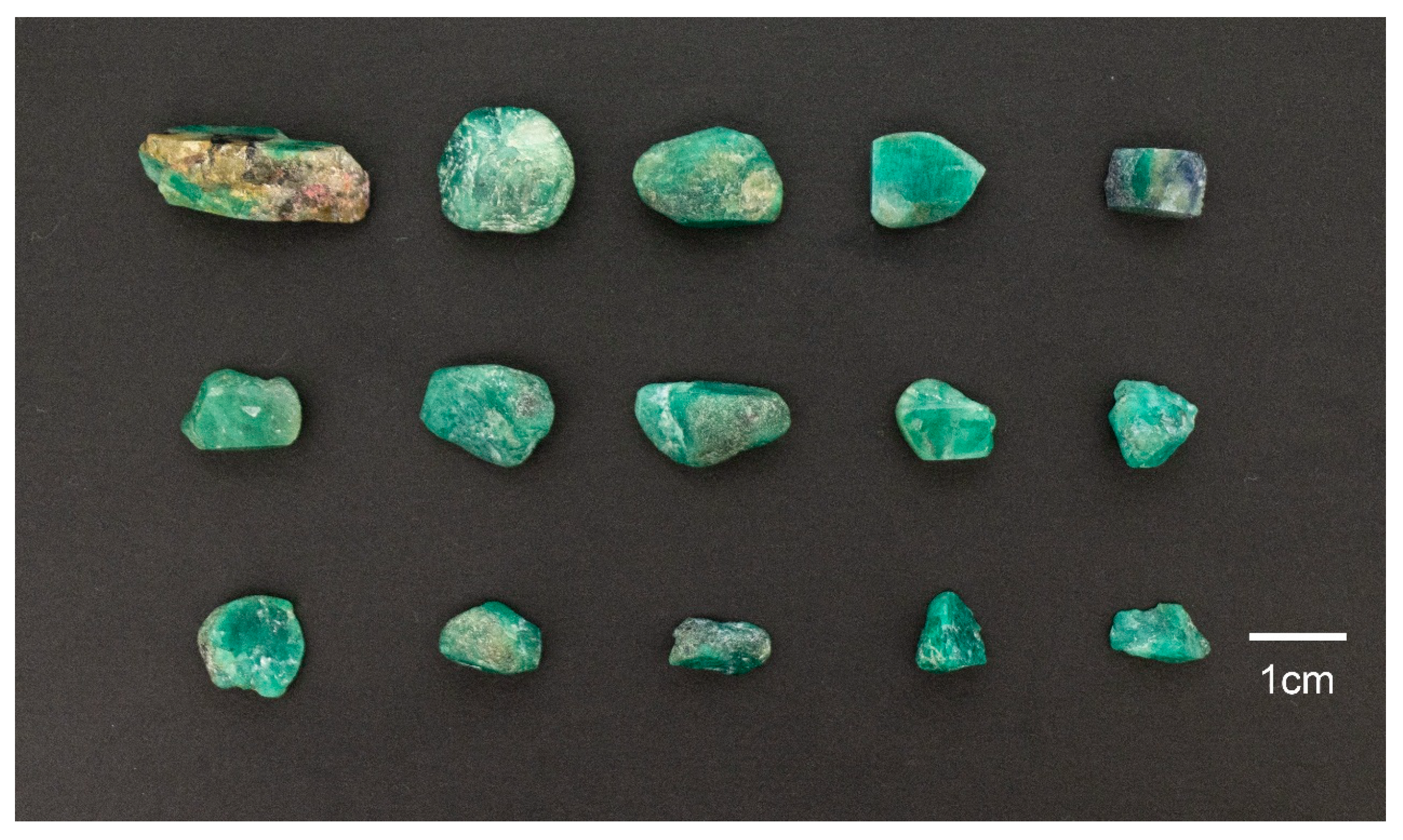

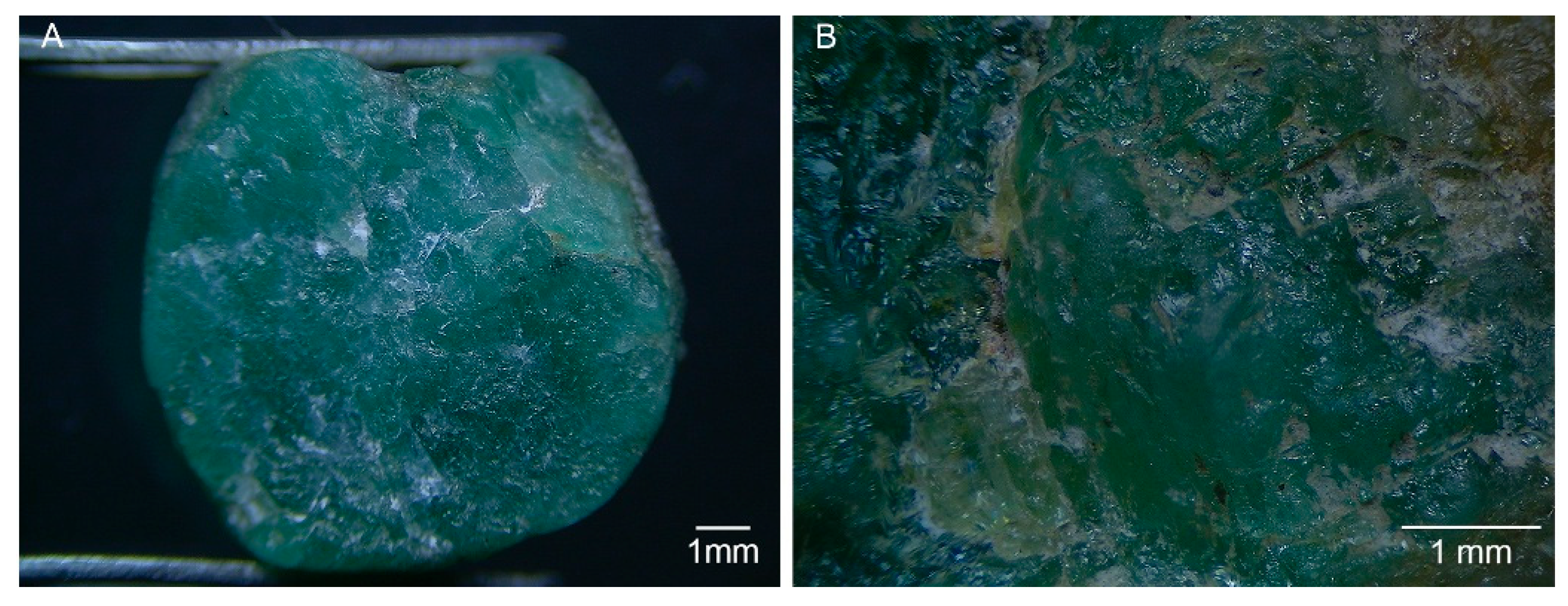

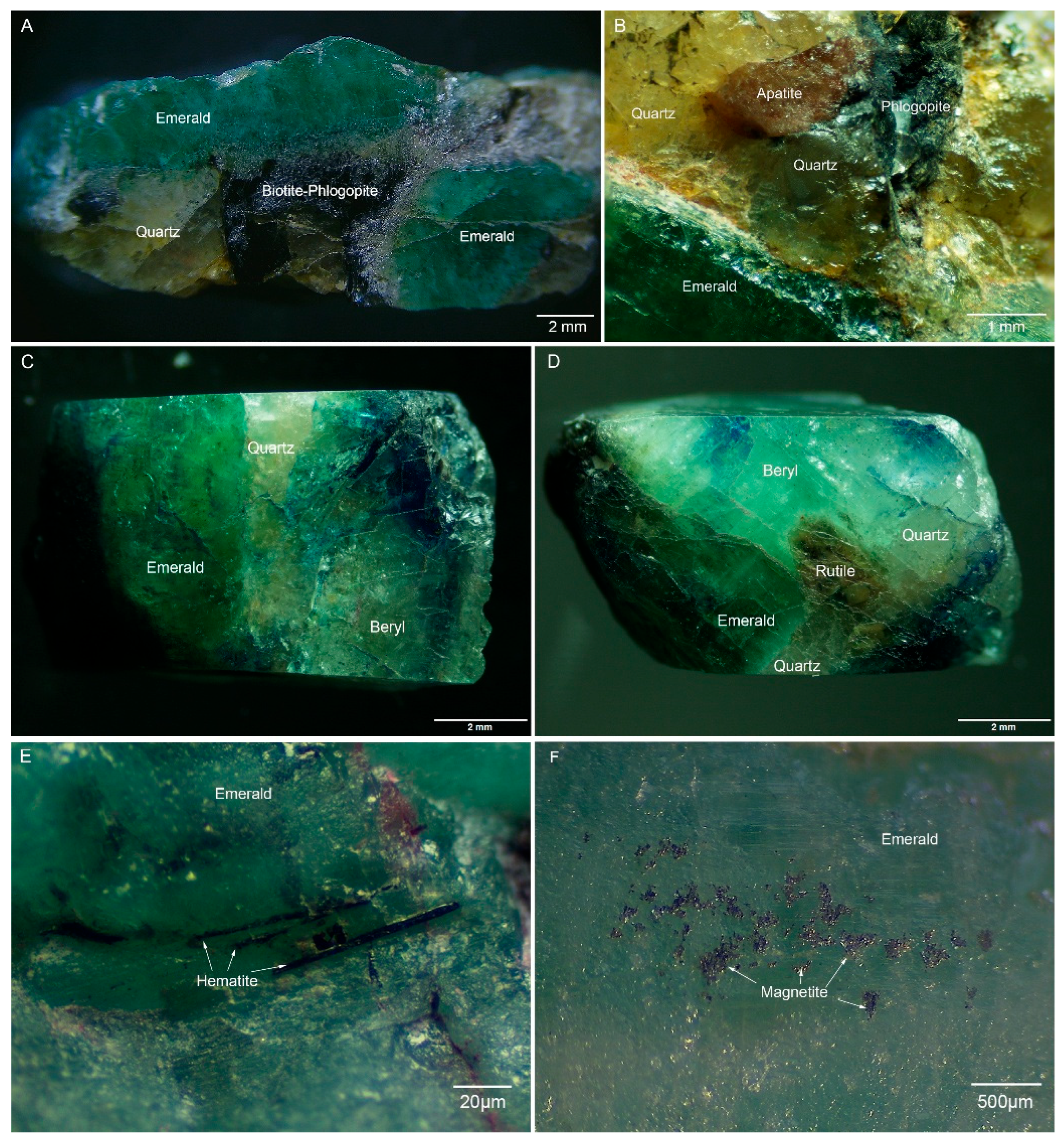
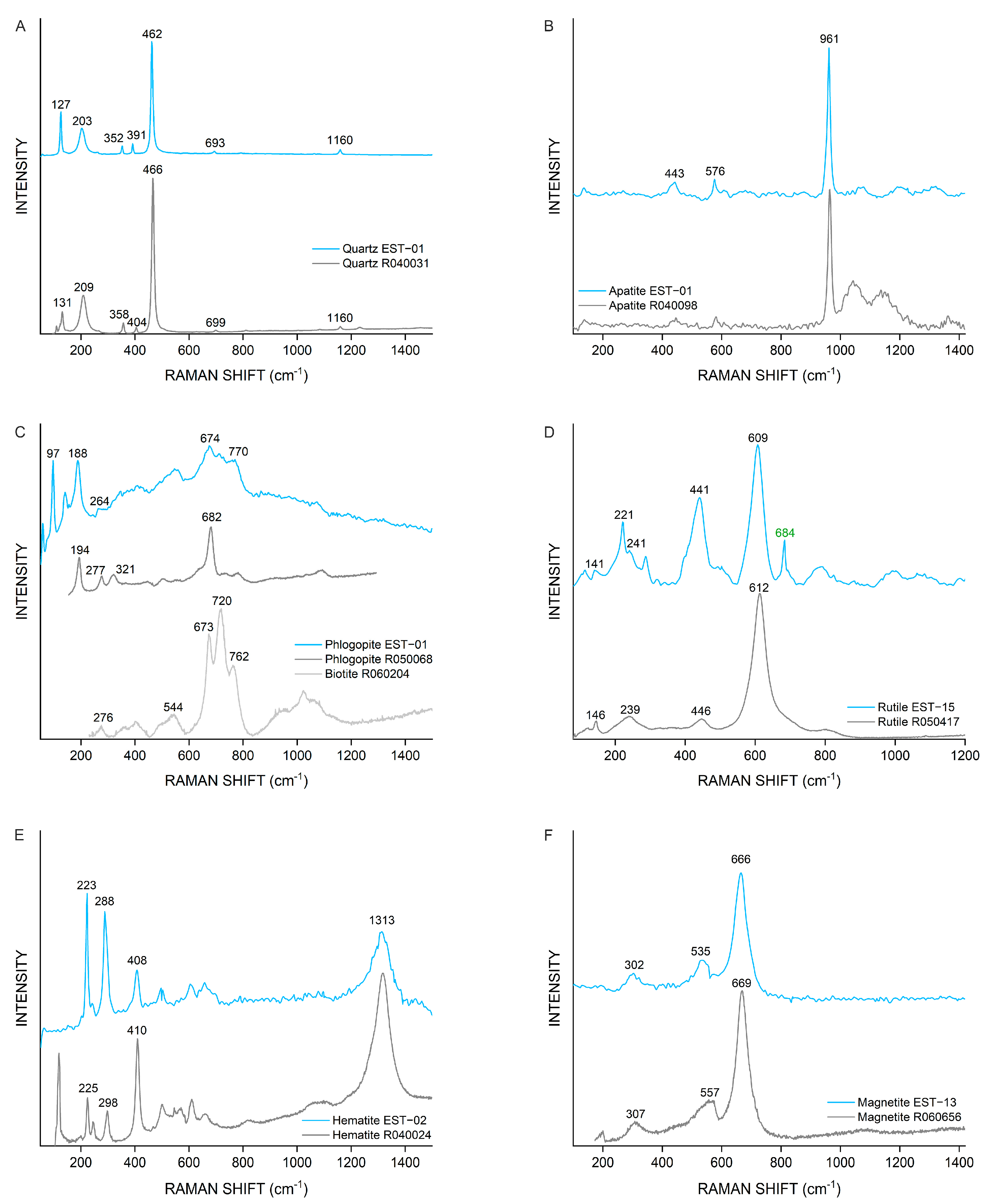



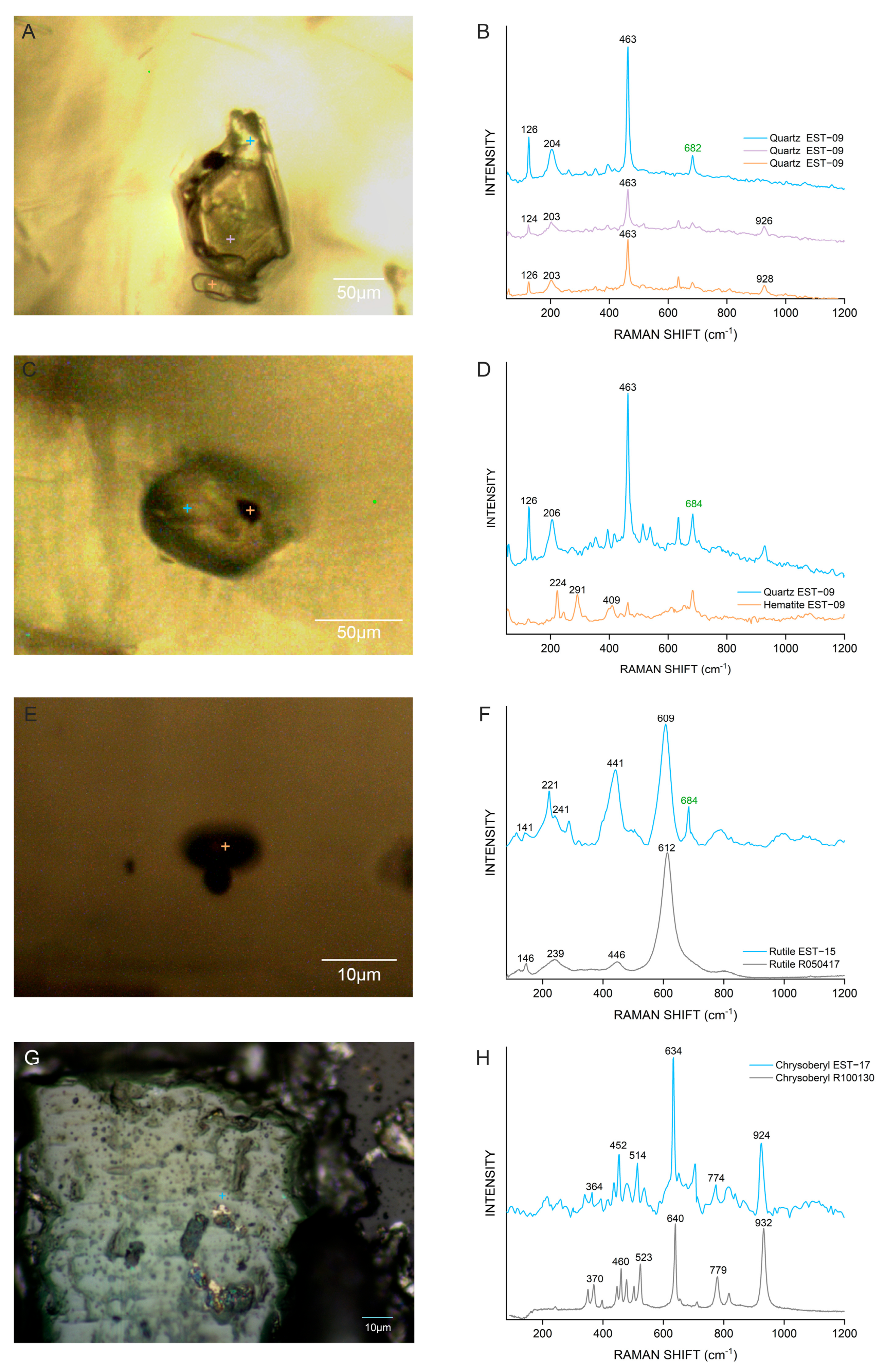

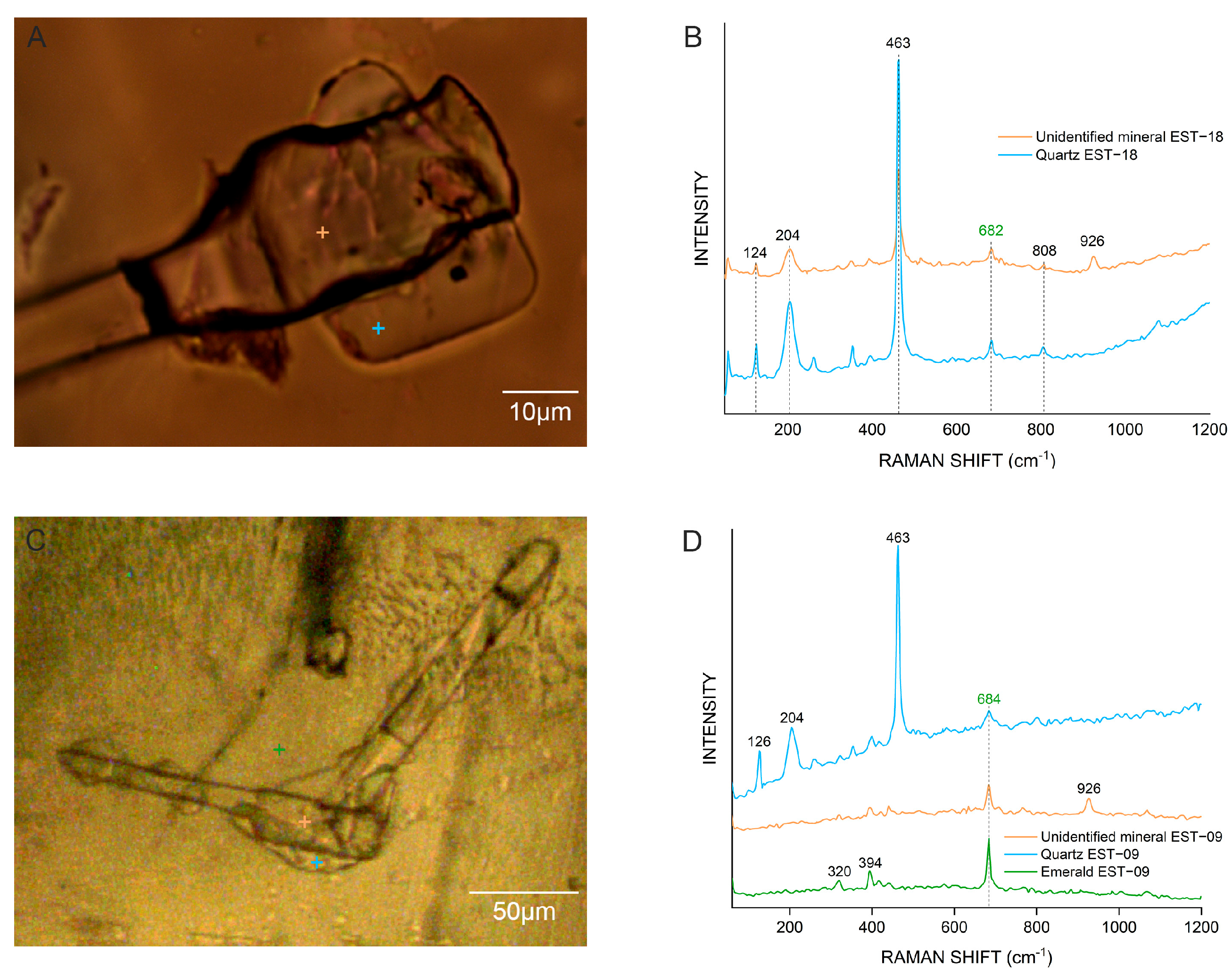


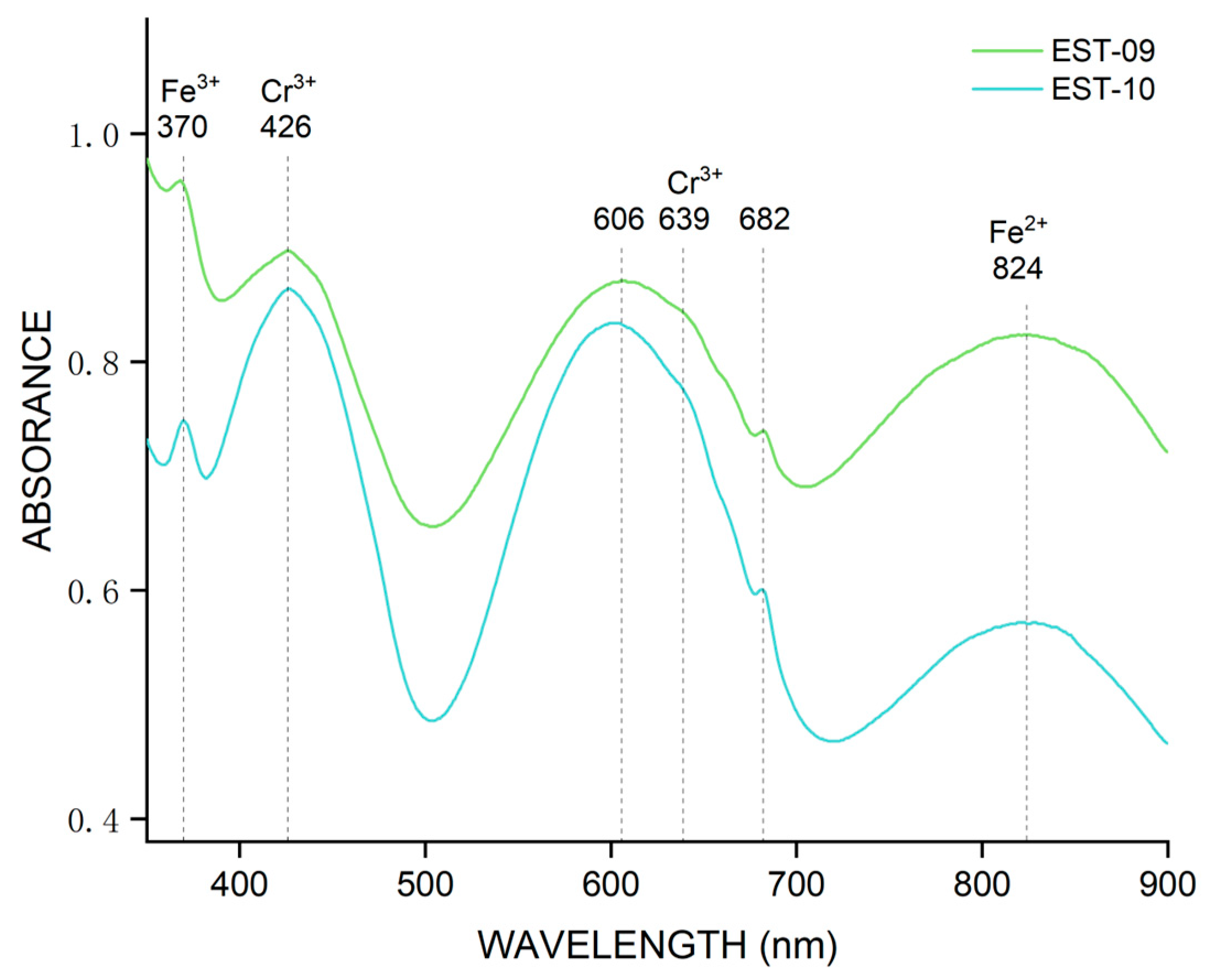

| Properties | Results |
|---|---|
| Color | Medium green to bluish green |
| Clarity | Medium to heavy included |
| Refractive indices | No = 1.577–1.581; Ne = 1.571–1.574 |
| Birefringence | 0.006–0.007 |
| Specific gravity | 2.66–2.72 |
| Pleochroism | Green (o-ray) and bluish green (e-ray) |
| Fluorescence | Inert |
| Chelsea filter | Red |
| External features | Rounded pebble morphologies with localized surface damage, displaying an abraded, frosted texture Parallel color bands of alternating light green and vivid green. |
| Internal features | Fingerprint-like fluid inclusions Abundant mineral inclusions: quartz, diaspore, chrysoberyl, apatite, hematite, magnetite, rutile, and anhydrite |
| Points | Na2O | MgO | Al2O3 | SiO2 | TiO2 | Cr2O3 | MnO | FeO | Total | Al | Si | Ti | Cr | Mn | Fe |
|---|---|---|---|---|---|---|---|---|---|---|---|---|---|---|---|
| 17-1 | 0.016 | 0.004 | 72.595 | 0.096 | - 1 | - 1 | 0.003 | 4.045 | 76.774 | 0.959 | 0.001 | 0 | 0 | 0.002 | 0.038 |
| 17-2 | - 1 | - 1 | 72.751 | 0.063 | 0.175 | 0.03 | - 1 | 5.404 | 78.455 | 0.835 | 0.001 | 0.102 | 0.018 | 0 | 0.044 |
| 17-3 | 0.014 | 0.035 | 71.556 | 0.262 | 0.054 | 0.02 | 0.011 | 4.718 | 76.721 | 0.900 | 0.003 | 0.035 | 0.013 | 0.007 | 0.042 |
| Points | EST-1-1 | EST-4-1 | EST-5-1 | EST-5-2 | EST-6-1 | EST-9-2 | EST-9-4 | EST-9-6 | EST-9-8 | EST-11-1 | EST-14-1 | EST-15-1 |
|---|---|---|---|---|---|---|---|---|---|---|---|---|
| SiO2 | 64.44 | 67.38 | 66.69 | 65.80 | 68.02 | 65.82 | 65.18 | 65.24 | 66.33 | 66.32 | 62.82 | 66.07 |
| Al2O3 | 16.37 | 17.87 | 18.23 | 16.86 | 17.28 | 17.19 | 17.39 | 17.55 | 17.84 | 16.25 | 16.36 | 16.64 |
| FeO | 1.25 | 0.84 | 0.93 | 1.01 | 0.84 | 1.17 | 1.00 | 0.90 | 0.79 | 1.06 | 1.04 | 0.77 |
| MnO | 0.01 | 0.01 | - 1 | - 1 | - 1 | 0.04 | - 1 | 0.05 | - 1 | 0.01 | 0.03 | - 1 |
| MgO | 1.18 | 0.53 | 0.51 | 1.02 | 0.63 | 1.02 | 0.87 | 0.63 | 0.49 | 1.12 | 1.04 | 0.67 |
| Cr2O3 | 0.64 | 0.07 | 0.03 | 0.31 | 0.02 | 0.17 | 0.27 | 0.25 | 0.09 | 0.45 | 0.26 | 0.24 |
| V2O5 | 0.02 | 0.02 | 0.03 | 0.03 | - 1 | 0.01 | 0.02 | 0.02 | 0.03 | - 1 | 0.02 | - 1 |
| TiO2 | - 1 | - 1 | 0.03 | - 1 | 0.04 | 0.03 | 0.02 | 0.02 | - 1 | 0.06 | 0.02 | 0.02 |
| CaO | - 1 | 0.01 | - 1 | - 1 | - 1 | 0.01 | - 1 | 0.02 | - 1 | 0.01 | 0.01 | - 1 |
| Na2O | 0.48 | 0.24 | 0.20 | 0.26 | 0.18 | 0.33 | 0.30 | 0.21 | 0.16 | 0.59 | 0.40 | 0.32 |
| K2O | 0.16 | 0.11 | 0.16 | 0.29 | 0.08 | 0.24 | 0.22 | 0.17 | 0.15 | 0.23 | 0.34 | 0.20 |
| BeO 2 | 13.61 | 14.15 | 13.95 | 13.88 | 14.36 | 13.85 | 13.68 | 13.67 | 13.90 | 14.07 | 13.22 | 13.97 |
| Total | 98.16 | 101.23 | 100.76 | 99.46 | 101.45 | 99.88 | 98.94 | 98.73 | 99.78 | 100.17 | 95.54 | 98.90 |
| Si 3 | 5.86 | 5.95 | 5.92 | 5.91 | 5.98 | 5.89 | 5.89 | 5.91 | 5.95 | 5.90 | 5.87 | 5.96 |
| Al | 1.76 | 1.86 | 1.91 | 1.78 | 1.79 | 1.81 | 1.85 | 1.87 | 1.88 | 1.70 | 1.80 | 1.77 |
| Fe2+ | 0.09 | 0.06 | 0.07 | 0.08 | 0.06 | 0.09 | 0.08 | 0.07 | 0.06 | 0.08 | 0.08 | 0.06 |
| Mg | 0.16 | 0.07 | 0.07 | 0.14 | 0.08 | 0.14 | 0.12 | 0.19 | 0.07 | 0.15 | 0.14 | 0.09 |
| Cr | 0.05 | 0.01 | 0.00 | 0.02 | 0.00 | 0.01 | 0.02 | 0.02 | 0.01 | 0.03 | 0.02 | 0.02 |
| Na | 0.09 | 0.04 | 0.03 | 0.04 | 0.03 | 0.06 | 0.05 | 0.04 | 0.03 | 0.10 | 0.07 | 0.02 |
| K | 0.02 | 0.01 | 0.02 | 0.03 | 0.01 | 0.03 | 0.03 | 0.02 | 0.02 | 0.03 | 0.04 | 0.02 |
| Be | 2.97 | 3.00 | 2.97 | 2.99 | 3.04 | 2.98 | 2.97 | 2.98 | 2.99 | 3.01 | 2.97 | 3.03 |
Disclaimer/Publisher’s Note: The statements, opinions and data contained in all publications are solely those of the individual author(s) and contributor(s) and not of MDPI and/or the editor(s). MDPI and/or the editor(s) disclaim responsibility for any injury to people or property resulting from any ideas, methods, instructions or products referred to in the content. |
© 2025 by the authors. Licensee MDPI, Basel, Switzerland. This article is an open access article distributed under the terms and conditions of the Creative Commons Attribution (CC BY) license (https://creativecommons.org/licenses/by/4.0/).
Share and Cite
Guo, Y.; Yu, X.-Y.; Li, C.-X. Investigation of the Gemological Characteristics and Types of Inclusions of Emeralds from Sumbawanga, Tanzania. Minerals 2025, 15, 1240. https://doi.org/10.3390/min15121240
Guo Y, Yu X-Y, Li C-X. Investigation of the Gemological Characteristics and Types of Inclusions of Emeralds from Sumbawanga, Tanzania. Minerals. 2025; 15(12):1240. https://doi.org/10.3390/min15121240
Chicago/Turabian StyleGuo, Yi, Xiao-Yan Yu, and Chen-Xi Li. 2025. "Investigation of the Gemological Characteristics and Types of Inclusions of Emeralds from Sumbawanga, Tanzania" Minerals 15, no. 12: 1240. https://doi.org/10.3390/min15121240
APA StyleGuo, Y., Yu, X.-Y., & Li, C.-X. (2025). Investigation of the Gemological Characteristics and Types of Inclusions of Emeralds from Sumbawanga, Tanzania. Minerals, 15(12), 1240. https://doi.org/10.3390/min15121240





